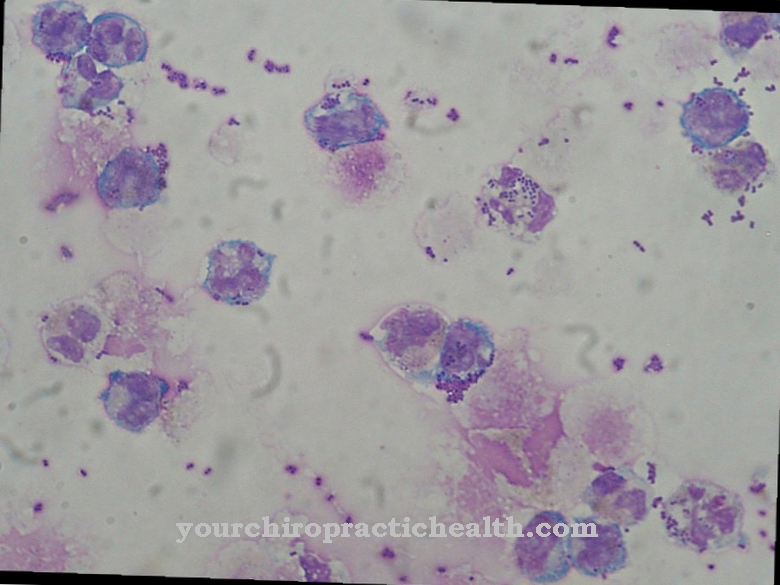The Hepatitis A virus causes a widespread infectious disease that occurs mainly in poorer regions of the world. According to the World Health Organization, around 1.4 million people develop it every year. The consequences include headache, nausea, and fever. Preventive vaccinations are possible.
What are hepatitis A viruses?
The hepatitis A virus is also called Enterovirus 72 because it belongs to the group of enteroviruses. These do not have a virus envelope and are acid-proof. The size of the virus is about 25 nanometers. Hepatitis A viruses cause the liver to become inflamed. The infection can be caused by contact with already infected persons or contaminated objects and food. There are also hepatitis viruses in versions B, C, D and E. In contrast to the hepatitis A virus, vaccination against the hepatitis C virus is not possible.
Certain occupational groups are at increased risk of infection due to the transmission possibilities. These include employees in hospitals, care facilities and day-care centers as well as in the food industry. There is also an increased risk for drug addicts and blood transfusions.
If symptoms occur, the blood and liver values are examined as part of the diagnosis. The symptoms do not always have to be clearly noticeable. In many cases they are mistaken for the signs of a flu-like infection. In contrast to the course of the disease with virus types B, C and D, disease caused by the hepatitis A virus is not chronic.
Occurrence, Distribution & Properties
The viruses are transmitted orally / fecally via a smear or contact infection. Vegetables fertilized with faeces are therefore one of the most common forms of disease transmission. In many cases, drinking water or the use of ice cubes is the cause of the transmission of the pathogen. The consumption of washed salads or ice cream is also one of the increased risks of possible infection with the virus. In addition, raw or undercooked seafood can cause infection. The dangers of illness are similar when eating mussels.
Neglecting hygiene when handling food and drinking water leads to the occurrence of hepatitis A viruses in many forms. Take care when brushing your teeth with tap water. It is very important to wash your hands regularly. This shouldn't just take place before consuming any food. Thorough hand washing also makes sense after touching doorknobs, banisters and flushing toilets as well as grab handles in public transport.
Focal areas of frequent illnesses are found in the Near and Middle East, West Africa and Mexico as well as in Algeria, India and South America. In addition, infections with the hepatitis A virus are increasing in Mediterranean countries such as Turkey, Tunisia, Egypt and Morocco. Hepatitis A viruses are also more common in Eastern Europe.
Illnesses & ailments
After an infection, the first symptoms appear on average after around 25 to 30 days. This can lead to headache, loss of appetite and nausea as well as vomiting, fever and pain in the area of the right costal arch. Itching can occasionally occur. In the further course, impairments such as light color of the stool, dark color of the urine and finally a yellow color of the skin can set in.
The extent of the symptoms occurring in the course of the disease can vary. Personal requirements such as age and state of health as well as the virus version play a major role. Symptoms can persist for several weeks. As a rule, they then regress on their own.
The risk of the disease being passed on to other people is most pronounced in the first phase, before the first symptoms are noticeable. The risk of infection then decreases significantly and after about a week there is no longer any risk of transmission.
Once the disease has resolved, there is lifelong immunity to the hepatitis A virus. Due to the hygiene regulations applicable in Germany and the practical observance in the food and catering industry, an infection with the virus is unlikely. The drinking water control also contributes to this. Nevertheless, a preventive vaccination makes sense. This ensures a high level of protection. Many holiday travelers also fly to foreign countries and thus sometimes to particularly endangered areas.
In around 10 percent of the diseases that occur, it can, atypically, take several months for the symptoms to resolve before they are completely healed. In very rare cases, 0.01 to 0.1 percent of patients develop a severe course of hepatitis up to liver failure. In the worst case, this course of the disease can lead to death. Patients who already suffer from chronic hepatitis B or C should in any case get vaccinated without traveling abroad. Otherwise, if you contract the hepatitis A virus, you run the risk of being exposed to a particularly serious disease course.
The risk of a severe course of the disease is increased from the age of 50. The most effective preventive measure is active vaccination. Effective protection occurs after the first vaccination. After six months, the vaccination is repeated to extend the effectiveness to 10 years. As with all vaccinations, complications can occur in exceptional cases. With existing neurological diseases or Cardiovascular problems should be weighed up when considering vaccination.
If it is not possible or desired to have a vaccination, there are further possibilities for prevention. If you are self-catering, fruits or vegetables should be cooked or peeled on vacation. Beverage combinations with ice cubes should be avoided. Sea animals should be sufficiently grilled or cooked for consumption.
There are no known specific treatment options for hepatitis A infections. Treating the symptoms that occur in each case is helpful. Classic bed rest helps to strengthen the immune system.

















.jpg)



.jpg)

.jpg)




